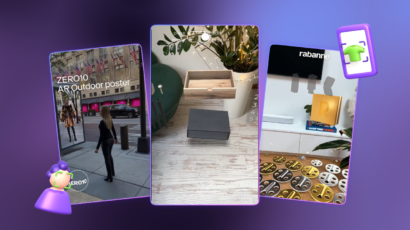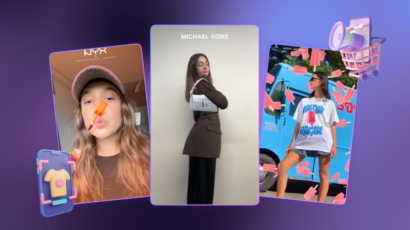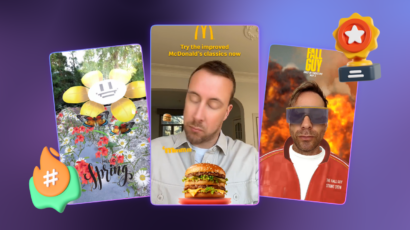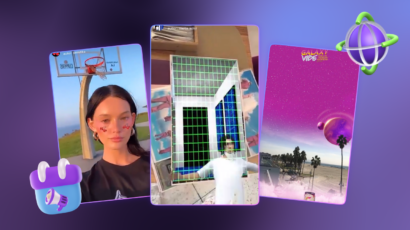With every scroll and swipe revealing an ocean of content, the quest to stand out has become an epic challenge.
Every marketer struggles with the endless need for new, eye-catching content that shines out in the noise of the digital world. However, this pursuit often collides with the reality of limited budgets, leaving us searching for innovative yet cost-effective solutions.
The good news is that the solution is right here at our fingertips; Augmented Reality (AR), a game-changing technology that not only enhances engagement but also offers a way to save money while advancing your marketing strategy.
Let’s explore how AR is changing the process of content creation and marketing strategy in general, even for those on a tight budget.
Content Fatigue & Budget Woes
Content creation fatigue is a common challenge for creators and businesses, driven by the consistent need for new material. Maintaining quality becomes difficult under pressure to produce more content. Traditional content creation methods like videography, photography, and design come with significant financial needs, including equipment costs and specialized expertise. To address these challenges, exploring alternative approaches like user-generated content and repurposing existing material can help manage costs. Prioritizing quality over quantity and establishing realistic production schedules are crucial in overcoming content creation fatigue while staying within budget.
AR: A Cost-Effective Game Changer
AR not only prioritizes meaningful experiences above endless information streams, but it does, in fact, offers a financially advantageous opportunity. When compared to traditional methods, this approach can drastically lower production costs without sacrificing the quality of immersive and captivating experiences.
Let’s have a look at the benefits:
- Focused Experience Development: By allocating resources to a single, immersive experience, expenses are minimized and quality is guaranteed.
- Reduced Production Costs: AR streamlines creation and lowers the need for real assets, which simplifies logistics.
- Reuse and Repurpose: By adapting AR content for multiple platforms, initial spending can be minimized as much as possible.
Cost-Effective AR Examples:
- Simple Filters: Easy to create, quite interesting with a lot of engagement potential.
- Virtual Product Placement: Reduce expenses by virtually showcasing products in authentic environments.
- Interactive games: at just a tiny portion of the expense, gamification is one of the best choices to go viral.
The Power of Engagement
AR has a unique ability to captivate and engage users in ways that traditional methods struggle to match. Here’s why AR drives engagement:
- AR drives engagement through active participation: Users interact in real time, manipulating virtual objects or exploring environments.
- Memorable experiences are created as users engage, forming strong connections with multi-sensory content.
- AR sparks curiosity by blending reality with virtual elements, prompting users to explore further.
- Highly shareable AR content encourages social sharing, extending its reach and impact.
Going Viral with AR
As already mentioned above, AR content’s novelty drives engagement and sharing, initiating a snowball effect. User-generated content amplifies its reach, leading to wider exposure on platforms like Instagram, TikTok, and Snapchat. This viral spread triggers algorithmic boosts, enhancing brand recognition and organic traffic.
What’s more, according to statistics, AR device users will grow steadily; by the end of 2023, the number has reached approximately 1.4 billion, and by 2024, it is estimated to increase to 1.73 billion.
Trending Topics & Competitive Edge
Successful AR campaigns serve as industry benchmarks and trendsetters, sparking conversations and positioning brands as innovative leaders. By pioneering immersive experiences, these campaigns enhance brand identity, drive engagement, and ultimately boost sales. Their ability to captivate audiences and drive tangible results underscores the importance of embracing AR technology in future marketing strategies, ensuring brands stay ahead of the curve. If you’re wondering how businesses use AR across the industries our suggestion for you is to read our another blog.
Actionable Step
Here’s a roadmap for incorporating AR into your marketing strategy:
- Define Your Target Audience and Brand Goals: understand their preferences, behaviors, and pain points. Use AR to enhance their experience and meet marketing objectives, like boosting brand awareness, sales, or engagement.
- Develop a Creative Concept: Generate AR concepts aligning with brand goals. Enhance products/services, and provide unique experiences. Ensure alignment with brand identity and values.
- Partner with AR Development Companies or Explore User-Friendly AR Creation Tools: Choose between partnering with AR development companies or using user-friendly AR creation tools based on budget, resources, and expertise. Here’s a reminder: you can always schedule a consultation with us.
- Measure and Analyze Results: Track KPIs like engagement rate, shares, conversions, and ROI. Use analytics tools for user data like time spent and demographics. Analyze for insights, refine campaigns, and iterate for continuous improvement.
Remember, by following these suggestions, you can effectively integrate AR into your marketing strategy to engage your target audience, achieve your brand goals, and drive meaningful results.
AR: Smart Strategy for Cost-Effective and High-Quality Marketing Content
It’s more than obvious that augmented reality isn’t just a trend anymore. It’s a game-changer for marketing; cost-effective, engaging, and has serious viral potential. Think about it as your secret weapon for creating innovative and competitive content that grabs attention and doesn’t let go. Integrating AR into your marketing mix can open doors to a wider audience and the chance to go viral. So, are you ready to jump on an AR-board?







